The last few years were tough for Country. The genre has always maintained its passionate fan base, but that fandom simply hadn’t translated into music consumption. From 2017 to 2022, when considering the combination of radio audience exposure, song sales, and streaming plays, a scant 2% of the most popular songs in the U.S.A. in any given week were Country songs, according to the Billboard all-genre Hot 100 chart.
Some programmers at the Country Radio Seminar (CRS) expressed such serious concern about the format’s future health in those years, you’d think they were discussing Smooth Jazz.
This year, everything changed.
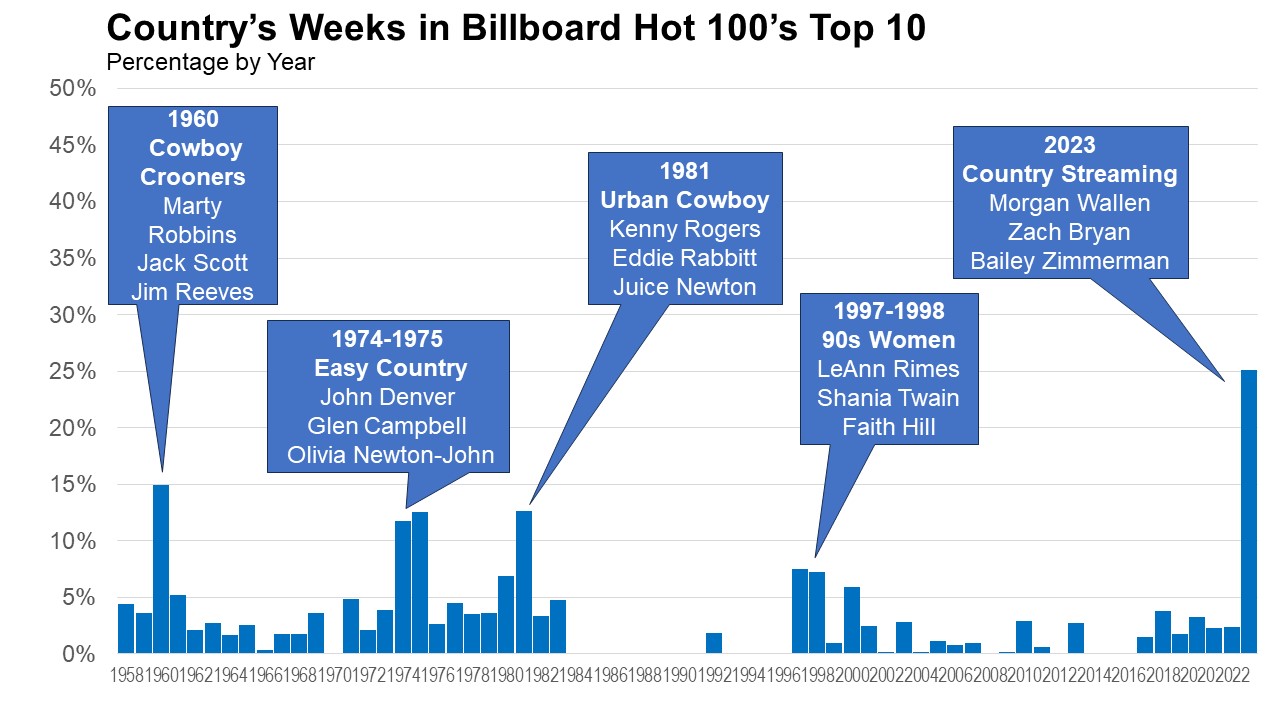
Country has enjoyed several popular periods during the Rock Era, but none as big as 2023
Through the end of September 2023, about a quarter of the Top 10 songs on Billboard’s all-genre Hot 100 chart in a typical week this year have been Country songs. Country is spending more time in the Hot 100’s Top 10 than any genre other than Pure Pop.
Yes, Country has even been bigger than Hip Hop in 2023
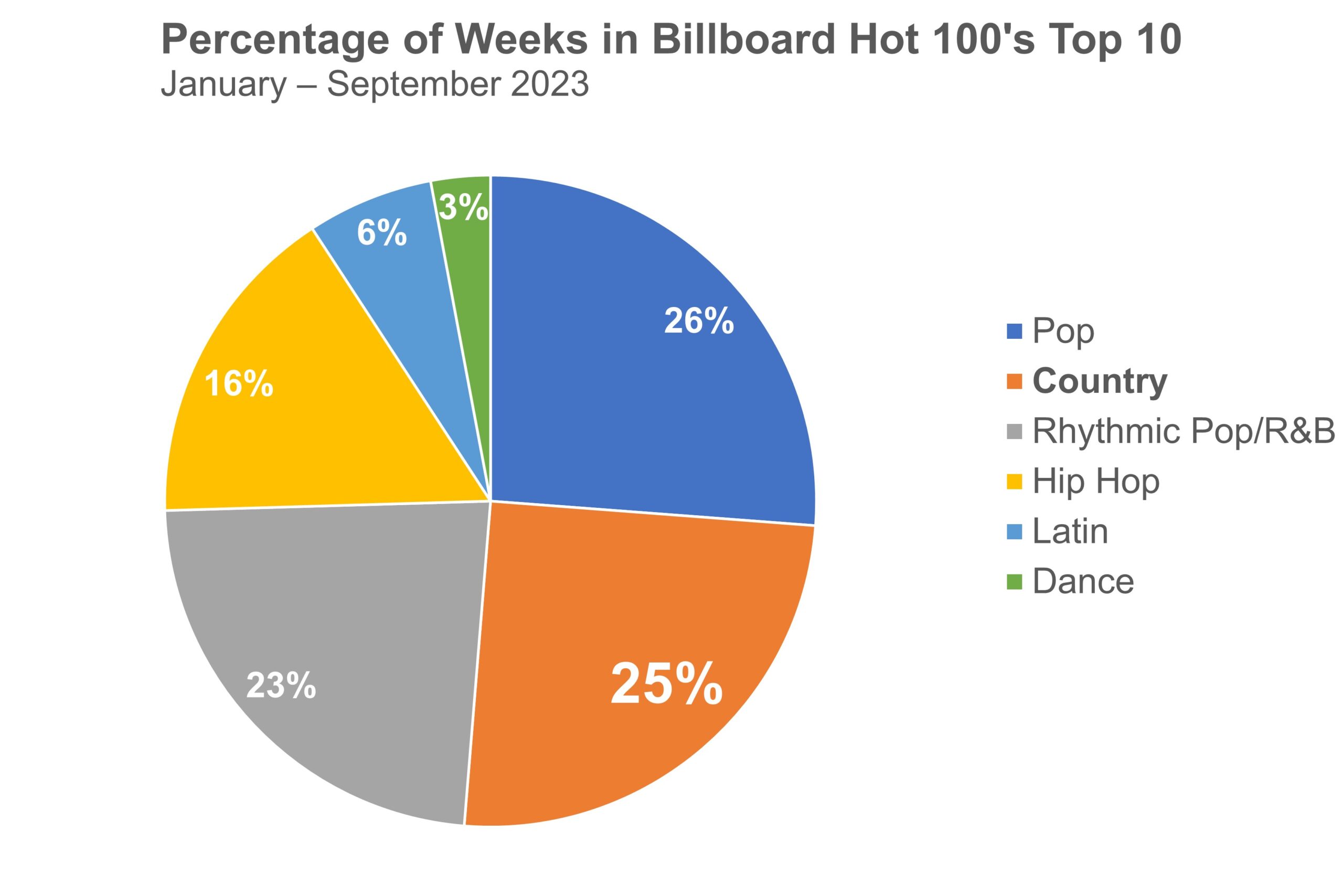
Some of those songs, such as Morgan Wallen’s “Last Night” and Luke Combs’ “Fast Car,” have also received significant CHR and AC radio airplay. Other songs, such as Zach Bryan’s 2022 holdover, “Something in the Orange,” have been massive streaming hits, even as Country radio hasn’t been quite sure what to make of it. Finally, some songs have been political lightning rods, namely Jason Aldean’s “Try That in a Small Town” and Oliver Anthony Music’s “Rich Men North of Richmond.”
This summer’s radio ratings confirm Country’s ascension. Country’s nationwide audience share grew 5% from this spring to this summer—the only contemporary format that grew in the summer of ’23.
Why is Country suddenly on fire and what does this burst of Country consumption mean for how you program your station? Let’s dive into three causes of Country music’s strong appeal—and one big thing that is not causing it.
REASON #1: COUNTRY FANS HAVE FINALLY EMBRACED STREAMING
When streaming eclipsed paid digital downloads in the mid 2010’s, Hip Hop fans were first to jump from iTunes to Spotify. As late as 2018, seven of the Top 10 most-streamed songs in the U.S were Hip Hop.
By 2021, however, mainstream Pop fans had fully embraced streaming. It was the first year that seven of the 10 biggest streaming hits were Pop, with the remaining three titles categorized as crossover Pop Hip Hop. Streaming finally mirrored mainstream CHR.
All the while, Country was Missing from Streaming.
Part of it was age. Unlike contemporary formats that appeal primarily to teens and young adults, Country appeals to everyone from Boy Scouts to Branson visitors. That audience includes a significant number of listeners over age 40 who had not given streaming a shot.
Some of it has been loyalty to their local Country stations. More so than other formats, Country listeners generally find their P1 station satisfies their musical appetite. If it ain’t broke, why fix it?
As with so many things in 2020-2022, however, the pandemic changed those habits.
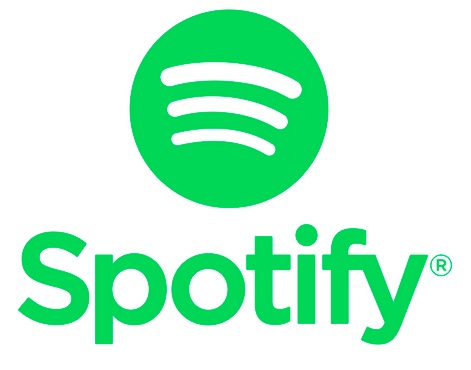
With commuting and lifestyle habits disrupted, Country fans sampled streaming and stuck with it. Country fans already comprised a strong portion of Amazon Music and Pandora users before 2020. Now, Country fans are now using Spotify, streaming music’s dominant platform. About 60 percent of Country radio listeners in our nationwide Integr8 USA Country research also listen to Spotify weekly—comparable to Alternative and Pop listeners nationwide.
With Country fans now fully embracing streaming, Country music’s total consumption is no longer reliant on airplay and song sales alone. In other words, Country’s consumption finally correlates to its fandom.
REASON #2: THE EMERGENCE OF NEW STARS THAT APPEAL TO YOUNGER FANS
The first Country superstar of the streaming era is Morgan Wallen. He appeals to the same young adult audience that’s been using Spotify and YouTube for years. However, Wallen is also arguably the first major Country artist to release music with streaming in mind, including famously long track-laden album releases and using TikTok to connect with fans.
Thanks in large part to his streaming numbers, Wallen has generated eight Top 10 hits on the all-genre Hot 100 chart. His Dangerous: The Double Album toppled 90s-era records for the album with the most weeks at Number 1.
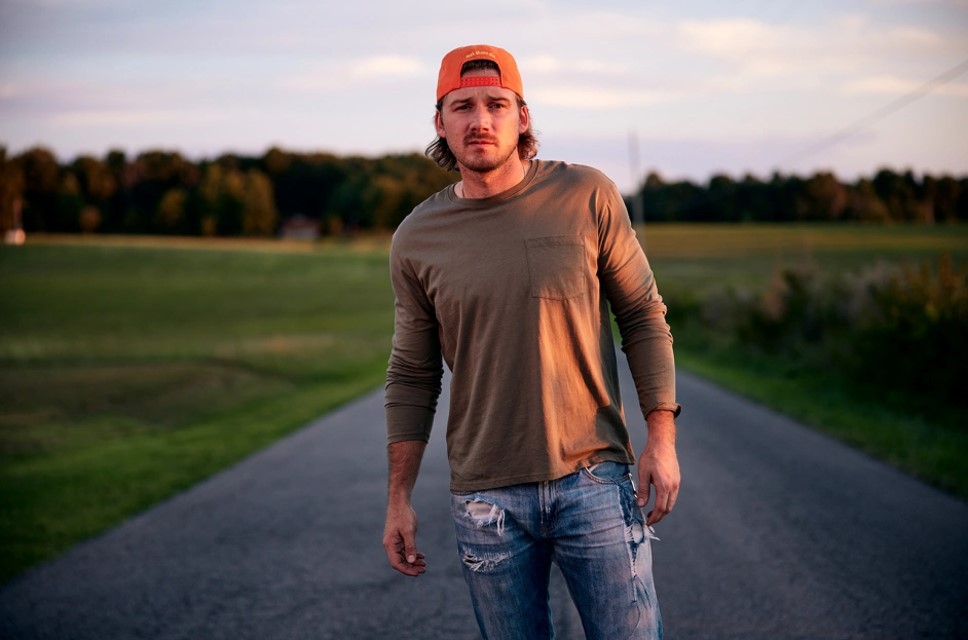
Like Wallen, Zach Bryan enjoys strong appeal among younger Country fans who grew up with streaming. However, he’s even further removed from the traditional tactics of Music Row, beginning his career by uploading his songs to YouTube and sharply criticizing the industry. While Country radio doesn’t know what to make of him, Bryan’s breakthrough hit “Something In The Orange” doesn’t need the airplay. It’s been among the most streamed songs on Spotify for well over a year now and Bryan is playing packed concerts because of it.
Country has a history of new superstars invigorating the genre with younger fans. Garth Brooks merged authenticity of late 80s New Traditionalism with the sensibilities of 70s Classic Rock to sell more albums than any other artist of the 1990s—in any genre.
REASON #3: COUNTRY HISTORICALLY DOES WELL WHEN CHR STRUGGLES
The early 80s were one of the darkest periods for Top 40 radio. Anti-disco backlash kept anything remotely rhythmic off most mainstream hit stations, but MTV-fueled New Wave hadn’t yet revitalized the format.
Amid those days of Air Supply and REO Speedwagon, Disco’s #1 movie star ditched his white suit for a black hat in Urban Cowboy, the 1980 film where John Travolta remakes Saturday Night Fever at Gilley’s nightclub in Pasadena, Texas. The movie sparked a cultural phenomenon that did for Country’s mainstream appeal what Saturday Night Fever did for Disco.
From 1980-1982. the Hot 100’s Top 10 included multiple pop-friendly hits from Kenny Rogers, Eddie Rabbitt and Juice Newton. Johnny Lee, Ronnie Milsap and The Oak Ridge Boys also found non-Country fans for bona-fide Country songs. Finally, Dolly Parton cemented her place as an American icon with both the movie and the song “9 to 5”.
This burst of interest in Country at a time when CHR is struggling isn’t unique. Guy Zapoleon’s 10-year music cycle shows that Country typically does well when CHR is in the depth of its Doldrums phase. Between Elvis and The Beatles in the early 60s, Rock ‘n’ Roll was awash with genuine Country classics from Marty Robbins and Jim Reeves, plus some Native American themed novelty songs better left in history’s dumpster.
During times when CHR struggles to find consensus hits, songs with Crossover potential are more prone to find a Pop audience, as Morgan Wallen’s “Last Night,” Luke Bryan’s remake of Tracy Chapman’s “Fast Car”, and Jelly Roll’s “Need A Favor” easily find an audience beyond Country’s core.
NOT A REASON: POLITICS
Of course, we have to talk about those songs.
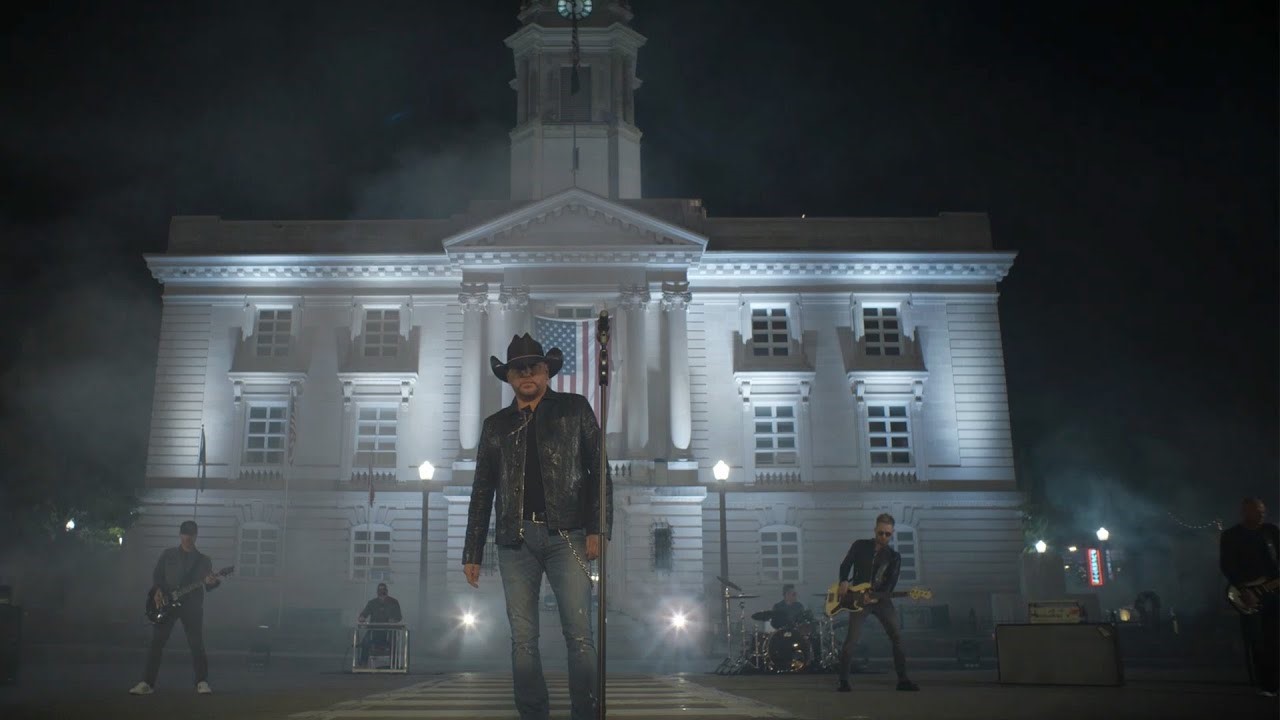
Two particular songs have received more attention than the rest of 2023’s Country hits for their political overtones: Jason Aldean’s “Try That In a Small Town” and Oliver Anthony Music’s “Rich Men North of Richmond.” On the charts, however, these two titles only account for 8% of Country’s time in the Top 10 this year, significantly underperforming non-political tunes from Morgan Wallen, Zach Bryan, and Bailey Zimmerman.
Our own Integr8 USA Country report, which surveys Country radio partisans nationwide, shows that more listeners dislike both “Small Town” and “Rich Men” songs than every other song we’re testing.
Yes, these tracks have ardent fans. But Country would still be having a historically phenomenal year without them.
ADVICE FOR RADIO
So how can your station maximize Country’s success? Here are three tips for Country programmers, plus one for Pop.
1) Fully examine the appeal of up-and-coming streaming stars with your audience. It’s been all too easy in recent years to assume artists like Zach Bryan and Kacey Musgraves are niche artists that don’t appeal to mainstream Country radio listeners. But listeners are changing. The Country artists that perform well on Spotify appeal to younger listeners in your audience. Yes, there may emerge some artists with strong streaming stories that simply don’t catch on with mainstream Country radio listeners. However, making that decision based solely on how they sound is a mistake. Examine these songs’ appeal in your own research (or in our Integr8 USA Country report) with the same thoroughness and patience you would give to traditional stars with proven track records. After all, today’s rebels are tomorrow’s legends.
2) Be careful with songs that make strong political statements. Songs that take strong stances on contested issues not only make the news; they also easily rile up an audience that wants to support that song’s statement. A few thousand iTunes downloads or a few days of binge-streaming can make a song look huge in the moment. Does that support for the statement translate into passion for the song? More importantly, does the song alienate a significant portion of your audience? Merle Haggard, Hank Williams Jr., Randy Travis, Garth Brooks and Brad Paisley have all had hits that made political statements on controversial cultural issues, so you shouldn’t rule out every song that takes a stand. Just be skeptical of the hype such songs have the power to generate today.
3) For CHR and AC stations, don’t ignore potential crossover hits. Both streaming data and callout research validate that several Country songs this year also appeal to Pop fans. Not every song has crossover potential. Some market’s non-Country P1s are more open to Country crossovers than other markets. As CHR and AC stations struggle to find strong songs from other genres, however, ignoring a song simply because its also a Country hit is a mistake.
4) Long range, remember that Country ebbs and flows, but it always endures. Radio history shows that Country is at its best when Top 40 Pop is at its worst. However, history has also shown when Pop inevitably makes a comeback with a reinvention of its style, Country struggles. When MTV New Wave reinvigorated CHR, Country was in crisis as the crossover appeal of the Urban Cowboy fad crashed. Burned by fickle city-slickers, Country embraced neo-traditionalism, a sound focused on Country’s core fans and traditional aesthetics. Randy Travis and George Strait became superstars. In turn, they launched the now revered 90s Country sound, including Garth Brooks. Country has been a viable radio format ever since the launch of the WSM Barn Dance in 1925 (which you know as the Grand Ole Opry).
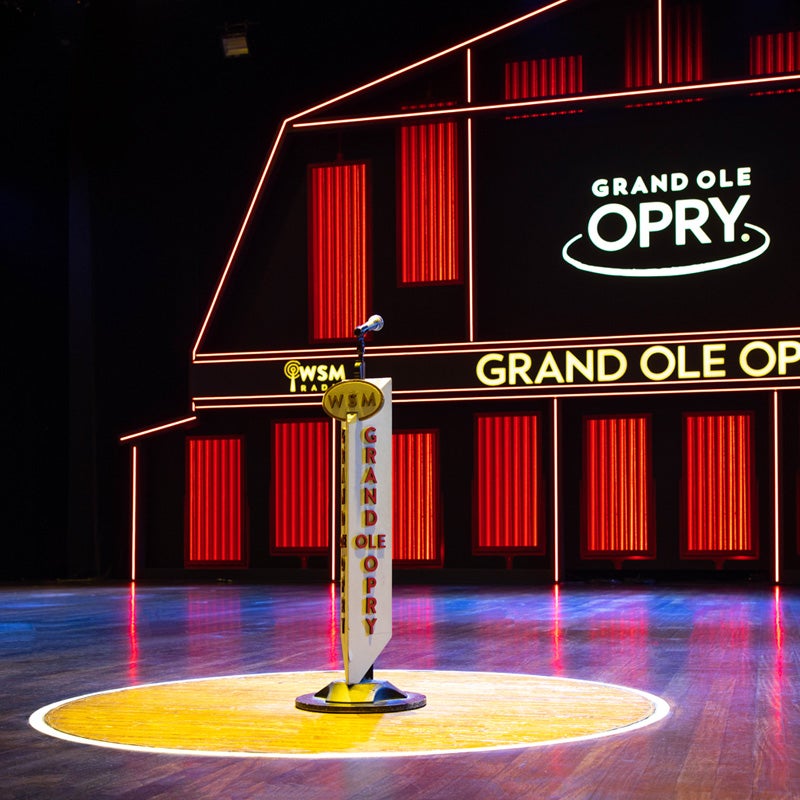

Pingback: Dissecting Country Music’s Rise To The Top Of The Charts. | Story - Gear Media